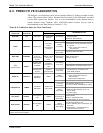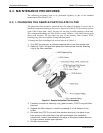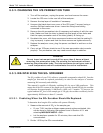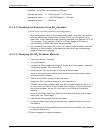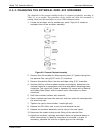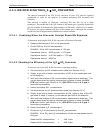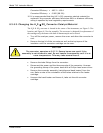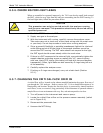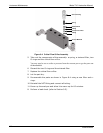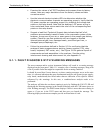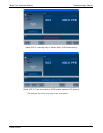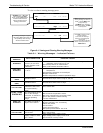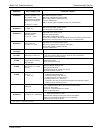
Model T101 Instruction Manual Instrument Maintenance
209
8.3.6. CHECKING FOR LIGHT LEAKS
When re-assembled or operated improperly, the T101 can develop small leaks around
the PMT, which let stray light from the analyzer surrounding into the PMT housing. To
find such light leaks, follow the procedures below.
CAUTION
This procedure can only be carried out with the analyzer running
and its cover removed. This procedure should only be carried out by
qualified personnel.
1. Scroll the TEST functions to PMT.
2. Supply zero gas to the analyzer.
3. With the instrument still running, carefully remove the analyzer cover.
Take extra care not to touch any of the inside wiring with the metal cover
or your body. Do not drop screws or tools into a running analyzer!
4. Shine a powerful flashlight or portable incandescent light at the inlet and
outlet fitting and at all of the joints of the sample chamber as well as
around the PMT housing. The PMT value should not respond to the light,
the PMT signal should remain steady within its usual noise.
5. If there is a PMT response to the external light, symmetrically tighten the
sample chamber mounting screws or replace the 1/4” vacuum tubing
with new, black PTFE tubing (this tubing will fade with time and become
transparent). Often, light leaks are also caused by O-rings being left out
of the assembly.
6. Carefully replace the analyzer cover.
7. If tubing or O-rings were changed, carry out a leak check (Section
9.5.1).
8.3.7. CHANGING THE CRITICAL FLOW ORIFICE
A critical flow orifice, located on the exhaust manifold maintains the proper flow rate of
gas through the T101 analyzer. Refer to section 10.3.3.1 for a detailed description of its
functionality
and location. Despite the fact this device is protected by sintered stainless
steel filters, it can, on occasion, clog, particularly if the instrument is operated without a
sample filter or in an environment with very fine, sub-micron particle-size dust.
1. Turn off power to the instrument and vacuum pump.
2. Locate the critical flow orifice on the pressure sensor assembly (called
out in Figure 8-4).
3. Disconnect
the p
neumatic line.
4. Unscrew the NPT fitting.
07266B DCN6485



